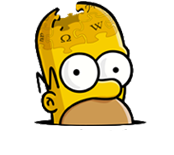
Difference between revisions of "The Wizard of Evergreen Terrace"
(New page: "'''The Wizard of Evergreen Terrace'''" is the second episode of the tenth season of ''The Simpsons''. It aired on [[September 2...) |
|||
| Line 23: | Line 23: | ||
{{Season 10}} | {{Season 10}} | ||
| + | {{DEFAULTSORT:Wizard of Evergreen Terrace, The}} | ||
[[Category:Episodes]] | [[Category:Episodes]] | ||
[[Category:Season 10]] | [[Category:Season 10]] | ||
Revision as of 10:43, December 10, 2007
"The Wizard of Evergreen Terrace" is the second episode of the tenth season of The Simpsons. It aired on September 20, 1998. The episode's title is an allusion to Thomas Edison's nickname, "the Wizard of Menlo Park".
Contents
Plot
Homer is shocked to hear on the radio that the average life expectancy for men is now 76.2 years, which makes him realize that at 38.1 years old , his life is half over. When he tells Marge this, she informs him that he is actually 39. Homer realizes that with time running out on his life, he hasn't accomplished anything, and this causes him to fall into a severe depression. Later when the family has a party to honor him, Lisa mentions that Thomas Edison invented the film projector as well as many other inventions Homer uses. Homer learns more about Edison and eventually idolises him. And so in an attempt to follow in Edison's footsteps, he quits his job at the power plant to become an inventor.
Homer gets to work and develops several inventions, such as an alarm that beeps every three seconds when everything is OK, a shotgun which shoots make-up onto women's faces, a very difficult to control electric hammer, and a reclining chair which has a built-in toilet. But none of these inventions is well received. Feeling despondent over his failure to invent anything useful, his invention career is saved when he reveals he added two hinged legs to a chair making it impossible to tip over backwards. However, his hopes are dashed when he notices his poster of Edison shows his idol sitting in the same type of chair, which indicates Edison has already invented Homer's untipable chair. But Homer also finds out no one else has seen the extra legs on Edison's chair, and thus Edison has never received public credit for inventing it. So he sets out with Bart and his electric hammer to the Edison Museum in New Jersey to destroy the chair. Before he smashes the chair, Homer notices a poster of Edison's which reveals that Edison idolized Leonardo da Vinci in the same way Homer idolizes Edison. It also shows that Edison was never able to match da Vinci's accomplishments, just as Homer can not match Edison's. Feeling a renewed connection to his hero Edison, Homer decides not to destroy the chair after all.
Unfortunately for Homer, he accidentally leaves his electric hammer at the museum. Later on the news, Kent Brockman announces that the chair and the electric hammer, have just been discovered in his museum and is expected to generate millions for Edison's already wealthy heirs.
Cultural references
Template:ListGenBot-SourceStart
- When Homer is reading about Edison at the library, one of the books on the table is called A Child's Garden Of Edison. This is a parody on A Child's Garden of Verses, a book of poetry by Robert Louis Stevenson.
- The electric hammer that Homer invents is very similar to one invented by the father in the 1984 film Gremlins. The character in the film also had a reputation for inventions that either did not work, or only worked for a couple of weeks.
- KITT from Knight Rider makes a cameo in this episode.
- At Homer's imagined funeral are President Lenny, Bishop Flanders, multiple-Oscar-winner Barney Gumble, the Robot from Lost in Space and, inexplicably, Heckle and Jeckle (whose names, interestingly enough, were also inspired by Robert Louis Stevenson – in this case his novella Strange Case of Dr. Jekyll and Mr. Hyde).
- Also at Homer's funeral is a tombstone marked "Tamzarian", which is Principal Skinner's true name.
- One of the T-shirts in the Thomas Edison Museum says AC/DC a reference to the rock band of the same name, who named themselves after seeing the terms "alternate current–direct current" on a sewing machine.
- While doing his experiments Homer writes formulas on a blackboard and writes the (present) density parameter of universe to be greater than 1 (Ω(t0) > 1) before an experiment and less than 1 (Ω(t0) < 1) after that experiment fails.
- The scene where Homer runs down the imaginary Edison is a reference to the story "The Hitchhiker" in the film "Creepshow 2".
